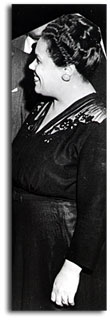
|
|
 |
||||||
|
|
|||||||
"I want to sing Harlem on an ebony flute."
Gwendolyn Bennett borrowed this line from William Rose Benet’s poem " Harlem" for the title and theme of her column "Ebony Flute". This column of literary criticism published in Opportunity for two years represents most of Bennett’s published work. "Ebony Flute" is important because it provided news about those who made up the period known as the Harlem Renaissance at its liveliest.
This period in Harlem between 1919 and 1930 was known for an outpouring of African-American literature, music, art, and political ideas. During this time, the National Urban League published the journal Opportunity. This journal edited by Charles S. Johnson is credited by some as creating the Renaissance by seeking out writers and artists from around the country. As assistant to the editor of Opportunity, Gwendolyn Bennett wrote the literary and fine arts column.
Gwendolyn Bennett was born July 8, 1902 in Giddings, Texas. Her parents, Joshua and Maime Bennett moved to Washington, DC so that Joshua could study law and Maime could train to be manicurist and beautician. The Bennetts eventually divorced and Maime was awarded custody of Gwendolyn. But seven-year-old Gwendolyn was kidnapped by her father, and she would not see her mother again until she was a teacher at Howard University. She and her father moved frequently, staying mostly in the cities and towns of Pennsylvania. When Gwendolyn was an honor student in high school, her father married Marechal Niel and the family moved to Brooklyn, New York.
 Gwendolyn
attended Brooklyn’s Girls High School, where she won the art contest, was
the first African-American student elected to the literary and drama societies,
and wrote both the class graduation speech and words to the graduation song.
After graduation in 1921, she
began preparing herself for a career in fine arts. She studied at Pratt Institute
for three years and took courses at Columbia University.
Gwendolyn
attended Brooklyn’s Girls High School, where she won the art contest, was
the first African-American student elected to the literary and drama societies,
and wrote both the class graduation speech and words to the graduation song.
After graduation in 1921, she
began preparing herself for a career in fine arts. She studied at Pratt Institute
for three years and took courses at Columbia University.
In June of 1924, Gwendolyn started teaching design, watercolor and crafts at Howard University. In December 1924, she was awarded a scholarship to study in Paris. She returned to teaching at Howard in 1926. Unfortunately, a fire at her stepmother’s home destroyed much of her artwork in 1926.
Bennett had also shown an early interest in creative writing. She had written and acted in her high school class play and composed several poems that were read to the new young writers in Harlem in the 1920s. She was only twenty-two years old when Charles S. Johnson, editor of Opportunity, introduced her to other black writers such as W.E.B. DuBois, Alain Locke, Zora Neale Hurston and James Weldon Johnson.
Bennett’s art was featured on the covers of Opportunity and the Messenger. From 1922-1934, her writings were appearing regularly in American Mercury, Crisis, Gypsy, Opportunity, Fire, Howard University Record, Palms and Southern Workman. Her works were included in popular anthologies of the time: Countee Cullen’s Caroling Dusk, Charles S. Johnson’s Ebony and Topaz and William Stanley Braithwaite’s Anthology of Magazine Verse for 1927.
Although Bennett never published a book of her own poetry, she is best known as a poet. Her artistic background often influenced her poetry. Her African heritage is also a main theme in her poetry, as in "To a Dark Girl" a poem about black beauty:
Oh, little brown girl, born for sorrow’s mate
Keep all you have of queenliness,
Forgetting that you once were slave,
And let your full lips laugh at fate!
Bennett published only two short stories, "Wedding Day" which appeared
in ![]() Fire!!
and "Tokens" which appeared in Ebony and Topaz
in 1927.
Fire!!
and "Tokens" which appeared in Ebony and Topaz
in 1927.
In 1937, Gwendolyn Bennett served as assistant to Director Augusta Savage of the Harlem Community Art Center. Within a year she was the director. In 1943, she was the Director of George Washington Carver School. After her retirement, she spent her remaining years in Kutztown, Pennsylvania, collecting and selling antiques. She died May 30, 1981.
Although her talents as a writer or painter never had a chance to grow, Gwendolyn Bennett was viewed by her peers as the most promising author of the Harlem Renaissance.
"Hatred." Opportunity 4 (June 1926): 190.
"Heritage." Opportunity 2 (December 1926): 371.
"Song." Palms 4 (October 1926): 21-22.
"Wedding Day." ![]() Fire!!
(November 1926): 26-28
Fire!!
(November 1926): 26-28
The following collections include Gwendolyn Bennett material:
Photo credit: Portrait of Gwendolyn Bennett, not dated, author unknown. Reproduced with permission, Photographs and Prints Division, Schomburg Center for Research in Black Culture, The New York Public Library. Astor, Lenox and Tilden Foundations.
biographies | harlem
renaissance books | links | timeline
black renaissance home | dclibrary.org
home
The Black Renaissance in Washington, D.C., 1920-1930s
http://www.dclibrary.org/blkren/
| last updated June 20, 2003